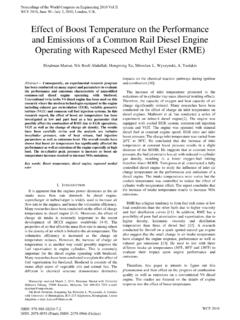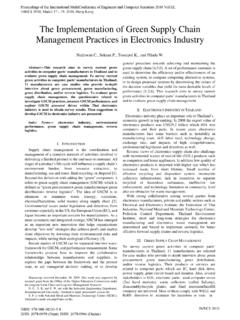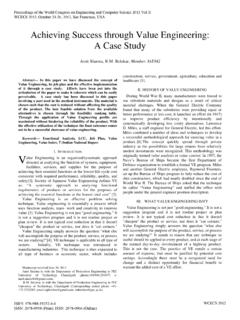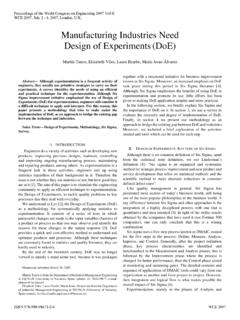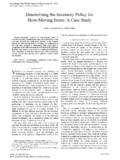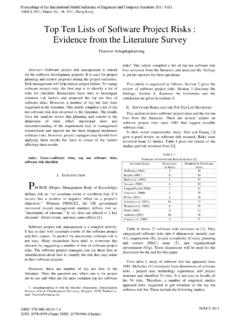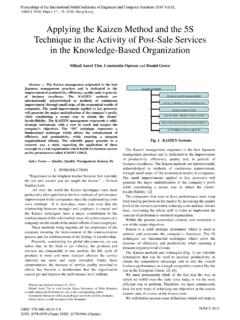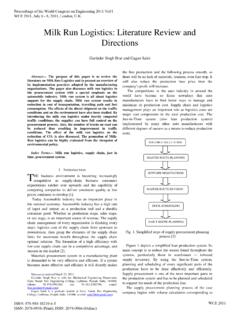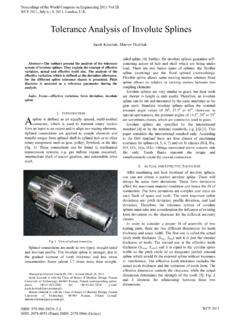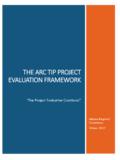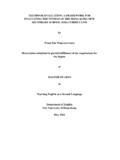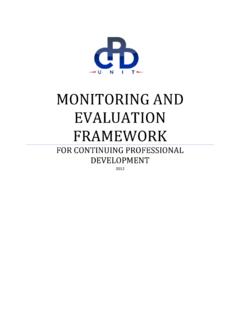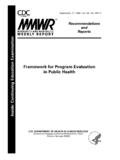Transcription of Supplier Evaluation Framework based on Balanced …
1 Abstract In this research a Supplier Evaluation Framework based on Balanced Scorecard (BSC) with integrated Corporate Social Responsibility (CSR) has been developed from literature review of 76 related papers. It was found that quality, delivery, and cost are the most significant criteria. Moreover, some criteria are changed according to shorten product life cycle, technologies, improvement of service, evolution of production system, and emergence of supply chain management (SCM). based on BSC and CSR, 5 perspectives namely financial, customer, internal business process, learning and growth, and corporate social responsibility are proposed for categorizing Supplier selection criteria.
2 Measures for each criterion are also collected for decision makers. This Framework is presented in the form of a table in which both criteria and measures are contained, this would be facilitated to use. Moreover, its BSC basis verifies suitability of a Supplier with the corporate strategies. As a consequence, evaluating Supplier using the proposed Framework can be helpful for decision makers to qualify the most eligible Supplier who can meet qualifications and buyer s strategies as well as environmental and social responsibility issues.
3 Index Terms Balanced Scorecard (BSC), Corporate Social Responsibility (CSR), Strategic Supplier Selection, Supplier Evaluation , Supplier Selection Criteria I. INTRODUCTION Supplier selection and Evaluation is one of the most critical activities in purchasing or procurement process [1]. This Evaluation process consists of 4 stages , defining objective, formulating the selection criteria, qualifying the suitable alternatives, and final selection. To qualify the prospective suppliers, the effective defining of selection criteria is necessary [2],[3].
4 Beyond the high significance on the product cost and partners relationship, it has considerable impacts on the buyer s corporate competencies [4],[5]. The early research by Dickson (1966) conducted a questionnaire and sent to 273 purchasing agents and managers selected from the list of the National Association of Purchasing Managers, cover USA and Canada. There are 170 mails regarding the 23 important criteria that were ranked Manuscript received December 30, 2008. W. Thanaraksakul is a Graduate Student of Industrial Engineering Department, Faculty of Engineering, Thammasat University Rangsit Campus, Klong Luang, Pathum Thani 12120, Thailand (corresponding author; e-mail: B.)
5 Phruksaphanrat is an Assistant Professor of Industrial Engineering Department, Faculty of Engineering, Thammasat University Rangsit Campus, Klong Luang, Pathum Thani 12120, Thailand (e-mail: with respect to the observation. He found that quality, delivery, performance history, and warranty policies are the most critical criteria for 1960s [6]. Afterward, there are many of researchers have conducted their research in this domain. In Weber et al. (1991) [2], based on 74 reviewed papers they found that price, delivery, production capacity, and location are the most often treated criteria.)
6 In other researches, many of them found that the cost, quality, and delivery are the most important criteria [2],[6]-[11]. Some paper noted that the choice of criteria may differ as a result of one culture to another [12]. However, it has been found that the 23 criteria presented in [6] still cover the majority of those presented in the literature until nowadays though some of them have been changed according to time [2],[13],[14]. The Balanced Scorecard (BSC) model was presented by Robert S. Kaplan and David P. Norton since 1992. It has been proposed to be a strategic approach and an organizational performance Evaluation which can be used for strategy and policy implementation [15].
7 It is included by 4 perspectives , financial, customer, internal business process, and learning and growth. Nevertheless, some authors recommend to charge the Corporate Social Responsibility (CSR) perspective, in term of environmental viewpoint, in a Supplier selection process as a result of recent massive emergence of global warming and social responsibility issues [16]-[18]. To obtain the Supplier whose strategies and qualifications harmonize with the buyer s objectives, an intensive study of criteria is needed. So, the 76 existing research papers are studied and compared.
8 Next, BSC and CSR are used to create a proposed Framework of a Supplier Evaluation for categorizing Supplier selection criteria. In this research, the 23 criteria in [6] are served as a principal for categorizing criteria. Some criteria those are not exactly match with the principal but hereabout relevant would be adopted into implicated categories and proper renamed , formerly the communication systems criterion was renamed to information technology and communication systems likes the attitude criterion was changed as attitude and strategic fit and so on.
9 Other criteria which could not be classified in any category of the principal will be added into the principal as new criteria namely, safety awareness, environmental and social responsibility, economical factors, terrorism risk, domestic political stability, quality system, innovation and R&D, customer relationship, product reliability, and cultural congruence. For this research, there are 76 relevant research papers containing Selection criteria , Supplier Evaluation , Supplier selection , and Vendor selection in their titles or keywords. Supplier Evaluation Framework based on Balanced Scorecard with Integrated Corporate Social Responsibility Perspective Worapon Thanaraksakul and Busaba Phruksaphanrat Proceedings of the International MultiConference of Engineers and Computer Scientists 2009 Vol IIIMECS 2009, March 18 - 20, 2009, Hong KongISBN: 978-988-17012-7-5 IMECS 2009 Table I Rank of Supplier selection criteria Criteria Abbr No.
10 Of Papers % Quality[6] QLT 74 Delivery[6] DLV 72 Cost[6] CST 72 Production facility and capacity[6] PFC 52 Flexibility and reciprocal arrangement[6] FLX 52 Technical capacity and support[6] TCS 49 Repair services and follow-up[6] RSF 45 Information technology and communication systems[6] ITC 41 Financial status[6] FNS 40 Innovation and R&D INV 38 Operating controls[6] OPR 34 Quality system QTS 33 Management and organization[6] MGT 32 Personnel training and development[6] PTD 24 Product reliability PRT 24 Performance history[6] PMH 23 Geographical location[6] GEO 23 Reputation and references[6] REP 21 Packaging and handling ability[6] PKG 18 Amount of past business[6] PSB 18 Customer relationship CTR 18 Warranties and claim policies[6] WCP 15 Procedural compliance[6] PCC 15 Customer satisfaction and impression[6] CSI 15 Attitude and strategic fit[6] ATD 14 Labor relations record[6] LRR 9 Economical aspect ECN 9 Desire for business[6]
